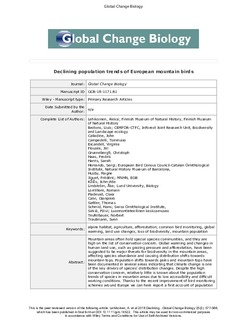| dc.contributor.author | Lehikoinen, Aleksi | |
| dc.contributor.author | Brotons, Lluís | |
| dc.contributor.author | Calladine, John | |
| dc.contributor.author | Campedelli, Tommaso | |
| dc.contributor.author | Escandell, Virginia | |
| dc.contributor.author | Flousek, Jiri | |
| dc.contributor.author | Grueneberg, Christoph | |
| dc.contributor.author | Haas, Fredrik | |
| dc.contributor.author | Harris, Sarah | |
| dc.contributor.author | Herrando, Sergi | |
| dc.contributor.author | Husby, Magne | |
| dc.contributor.author | Jiguet, Frédéric | |
| dc.contributor.author | Kålås, John Atle | |
| dc.contributor.author | Lindström, Åke | |
| dc.contributor.author | Lorrillière, Romain | |
| dc.contributor.author | Molina, Blas | |
| dc.contributor.author | Pladevall, Clara | |
| dc.contributor.author | Calvi, Gianpiero | |
| dc.contributor.author | Sattler, Thomas | |
| dc.contributor.author | Schmid, Hans | |
| dc.contributor.author | Sirkiä, Päivi M. | |
| dc.contributor.author | Teufelbauer, Norbert | |
| dc.contributor.author | Trautmann, Sven | |
| dc.date.accessioned | 2019-02-22T14:22:34Z | |
| dc.date.available | 2019-02-22T14:22:34Z | |
| dc.date.created | 2019-01-28T14:52:25Z | |
| dc.date.issued | 2018 | |
| dc.identifier.citation | Lehikoinen, A., Brotons, L., Calladine, J., Campedelli, T., Escandell, V.,Flousek, J., ... Trautmann, S. (2018). Declining population trends of European mountain birds. Global Change Biology, 25(2), 577-588. doi: | nb_NO |
| dc.identifier.issn | 1365-2486 | |
| dc.identifier.uri | http://hdl.handle.net/11250/2587090 | |
| dc.description | Author's accepted version (post-print). | nb_NO |
| dc.description | This is the peer reviewed version of the following article: Lehikoinen, A., Brotons, L., Calladine, J., Campedelli, T., Escandell, V.,Flousek, J., ... Trautmann, S. (2018). Declining population trends of European mountain birds. Global Change Biology, 25(2), 577-588, which has been published in final form at https://doi.org/10.1111/gcb.14522. This article may be used for non-commercial purposes in accordance with Wiley Terms and Conditions for Use of Self-Archived Versions. | |
| dc.description | Available from 12/12/2019. | |
| dc.description.abstract | Mountain areas often hold special species communities, and they are high on the list of conservation concern. Global warming and changes in human land use, such as grazing pressure and afforestation, have been suggested to be major threats for bio- diversity in the mountain areas, affecting species abundance and causing distribution shifts towards mountaintops. Population shifts towards poles and mountaintops have been documented in several areas, indicating that climate change is one of the key drivers of species’ distribution changes. Despite the high conservation concern, relatively little is known about the population trends of species in mountain areas due to low accessibility and difficult working conditions. Thanks to the recent improvement of bird monitoring schemes around Europe, we can here report a first account of population trends of 44 bird species from four major European mountain regions: Fennoscandia, UK upland, south‐western (Iberia) and south‐central moun- tains (Alps), covering 12 countries. Overall, the mountain bird species declined signif- icantly (−7%) during 2002–2014, which is similar to the declining rate in common birds in Europe during the same period. Mountain specialists showed a significant −10% decline in population numbers. The slope for mountain generalists was also negative, but not significantly so. The slopes of specialists and generalists did not differ from each other. Fennoscandian and Iberian populations were on average declining, while in United Kingdom and Alps, trends were nonsignificant. Tempera- ture change or migratory behaviour was not significantly associated with regional population trends of species. Alpine habitats are highly vulnerable to climate change, and this is certainly one of the main drivers of mountain bird population trends. However, observed declines can also be partly linked with local land use practices. More efforts should be undertaken to identify the causes of decline and to increase conservation efforts for these populations. | nb_NO |
| dc.language.iso | eng | nb_NO |
| dc.publisher | Wiley | nb_NO |
| dc.title | Declining population trends of European mountain birds | nb_NO |
| dc.type | Journal article | nb_NO |
| dc.type | Peer reviewed | nb_NO |
| dc.description.version | acceptedVersion | nb_NO |
| dc.subject.nsi | VDP::Zoologiske og botaniske fag: 480 | nb_NO |
| dc.subject.nsi | VDP::Zoology and botany: 480 | nb_NO |
| dc.source.pagenumber | 577-588 | nb_NO |
| dc.source.volume | 25 | nb_NO |
| dc.source.journal | Global Change Biology | nb_NO |
| dc.source.issue | 2 | nb_NO |
| dc.identifier.doi | 10.1111/gcb.14522 | |
| dc.identifier.cristin | 1666615 | |
| dc.relation.project | Norwegian Environment Agency | nb_NO |
